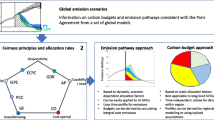Abstract
The Paris Agreement for a post-2020 international framework for tackling climate change was adopted in December 2015. The agreement requires that each country prepares and communicates nationally determined contributions (NDCs) every 5 years, including greenhouse gas (GHG) emission reduction targets. Most countries submitted NDCs before the Paris Agreement. According to our analyses using a global energy and GHG emission reduction assessment model, the emission reduction costs of the NDCs vary widely among countries; and those differences will induce carbon leakage, thus the expected global emission reduction is smaller than that predicted by simply aggregating the emission reductions of all the countries. Moreover, the emissions are larger than those required for the pathways leading to a high probability of temperature stabilization at below 2 °C above pre-industrial levels. To fill the gap, a rigorous review process employing robust indicators measuring emission reduction efforts is crucial. However, the development and deployment of innovative technologies with cheaper costs is even more significant.







Similar content being viewed by others
References
Akimoto K, Sano F, Homma T, Oda J, Nagashima M, Kii M (2010) Estimates of GHG emission reduction potential by country, sector, and cost. Energy Policy 38(7):3384–3393
Akimoto K, Homma T, Sano F, Nagashima M, Tokushige K, Tomoda T (2014) Assessment of the emission reduction target of halving CO2 emissions by 2050: macro-factors analysis and model analysis under newly developed socio-economic scenarios. Energy Strategy Rev 2(3–4):246–256
Aldy J, Pizer B (2016) Alternative metrics for comparing domestic climate change mitigation efforts and the emerging international climate policy architecture. Rev Environ Econ Policy 10(1):3–24
Aldy J, Pizer B, Akimoto K (2016) Comparing emission mitigation effort. Clim Policy. doi:10.1080/14693062.2015.119098
Geden O (2015) Policy: climate advisers must maintain integrity. Nature 521:27–28
IPCC (2001) Climate change 2001: the scientific basis. Contribution of working group I to the third assessment report of the intergovernmental panel on climate change. Cambridge University Press
IPCC (2007) Climate Change 2007: the scientific basis. Contribution of working group I to the fourth assessment report of the intergovernmental panel on climate change. Cambridge University Press
IPCC (2013) Climate change 2013: the physical science basis. Contribution of working group I to the fifth assessment report of the intergovernmental panel on climate change. Cambridge University Press
IPCC (2014) Climate change 2014: mitigation of climate change contribution of working group III to the fifth assessment report of the intergovernmental panel on climate change. Cambridge University Press
Kaya Y, Yamaguchi M, Akimoto K (2015) The uncertainty of climate sensitivity and its implication for the Paris negotiation. Sustain Sci. doi:10.1007/s11625-015-0339-z
Meinshausen M, Raper SCB, Wigley TML (2011) Emulating coupled atmosphere-ocean and carbon cycle models with a simpler model, MAGICC6–part 1: model description and calibration. Atmos Chem Phys 11:1417–1456
RITE, NIES (2015) MILES (modelling and informing low emissions strategies) project–Japan policy paper: a joint analysis of Japan’s INDC. http://www-iam.nies.go.jp/aim/publications/report/2015/miles_japan.pdf. Accessed 28 Jan 2016
Sano F, Akimoto K, Homma T, Tokushige K (2016) Evaluations on the Japan’s greenhouse gas emission reduction target for 2030. J Jpn Soc Energy Resour 37(1):51–60 (in Japanese)
Tavoni M et al (2015) Post-2020 climate agreements in the major economies assessed in the light of global models. Nat Clim Change 5:119–126
Tollefson J (2015) Is the 2 °C world a fantasy? Nature 527:436–438
UNFCCC (2015) Adoption of the Paris agreement. http://unfccc.int/resource/docs/2015/cop21/eng/l09.pdf. Accessed 28 Jan 2016
Victor DG, Kennel CF (2014) Climate policy: ditch the 2 °C warming goal. Nature 514:30–31
Author information
Authors and Affiliations
Corresponding author
Appendix: Overview of the global energy and GHG emission reduction assessment model DNE21+
Appendix: Overview of the global energy and GHG emission reduction assessment model DNE21+
The DNE21+ model (Akimoto et al. 2010; 2014) is an intertemporal linear programming model for the assessment of global energy systems and global warming mitigation in which the worldwide costs are to be minimized. The model represents regional differences, and assesses detailed energy-related CO2 emission reduction technologies up to 2050. When any emission restriction (e.g., an upper limit of emissions, emission reduction targets, targets of energy or emission intensity improvements, or carbon taxes) is applied, the model specifies the energy systems whose costs are minimized, meeting all the assumed requirements, including assumed production for industries such as iron and steel, cement, and paper and pulp, transportation by automobile, bus, and truck, and other energy demands. The energy supply sectors are hard-linked with the energy end-use sectors, including energy exporting/importing, and the lifetimes of facilities are taken into account so that assessments are made with complete consistency kept over the energy systems. Salient features of the model include (1) analysis of regional differences between 54 world regions while maintaining common assumptions and interrelationships, (2) a detailed evaluation of global warming response measures that involves modeling of about 300 specific technologies that help suppress global warming, and (3) explicit facility replacement considerations over the entire time period. Based on the plausible ranges derived from the relevant literature, the model assumes energy efficiency improvements in several kinds of technologies and cost reductions of renewable energies, carbon dioxide capture and storage (CCS), amongst others.
About this article
Cite this article
Akimoto, K., Sano, F. & Tehrani, B.S. The analyses on the economic costs for achieving the nationally determined contributions and the expected global emission pathways. Evolut Inst Econ Rev 14, 193–206 (2017). https://doi.org/10.1007/s40844-016-0049-y
Published:
Issue Date:
DOI: https://doi.org/10.1007/s40844-016-0049-y
Keywords
- Climate change mitigation
- Greenhouse gas emission
- Marginal abatement cost
- Nationally determined contributions
- Emission pathway




